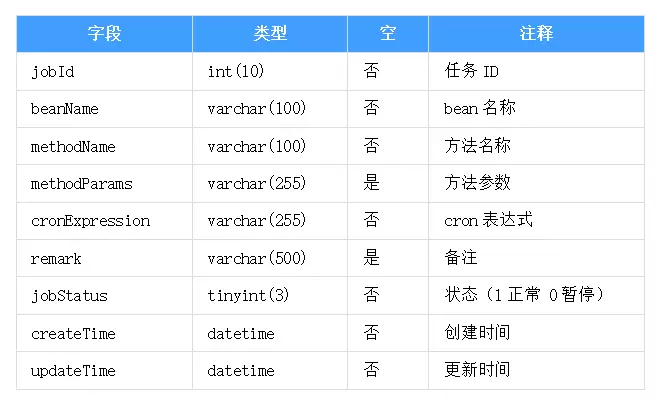在spring boot项目中,可以通过@EnableScheduling注解和@Scheduled注解实现定时任务,也可以通过SchedulingConfigurer接口来实现定时任务。但是这两种方式不能动态添加、删除、启动、停止任务。要实现动态增删启停定时任务功能,比较广泛的做法是集成Quartz框架。但是本人的开发原则是:在满足项目需求的情况下,尽量少的依赖其它框架,避免项目过于臃肿和复杂。查看spring-context这个jar包中org.springframework.scheduling.ScheduledTaskRegistrar这个类的源代码,发现可以通过改造这个类就能实现动态增删启停定时任务功能。


添加执行定时任务的线程池配置类
1
2
3
4
5
6
7
8
9
10
11
12
| @Configuration
public class SchedulingConfig {
@Bean
public TaskScheduler taskScheduler() {
ThreadPoolTaskScheduler taskScheduler = new ThreadPoolTaskScheduler();
taskScheduler.setPoolSize(4);
taskScheduler.setRemoveOnCancelPolicy(true);
taskScheduler.setThreadNamePrefix("TaskSchedulerThreadPool-");
return taskScheduler;
}
}
|
添加ScheduledFuture的包装类。ScheduledFuture是ScheduledExecutorService定时任务线程池的执行结果。
1
2
3
4
5
6
7
8
9
10
11
12
13
14
| public final class ScheduledTask {
volatile ScheduledFuture<?> future;
public void cancel() {
ScheduledFuture<?> future = this.future;
if (future != null) {
future.cancel(true);
}
}
}
|
添加Runnable接口实现类,被定时任务线程池调用,用来执行指定bean里面的方法。
1
2
3
4
5
6
7
8
9
10
11
12
13
14
15
16
17
18
19
20
21
22
23
24
25
26
27
28
29
30
31
32
33
34
35
36
37
38
39
40
41
42
43
44
45
46
47
48
49
50
51
52
53
54
55
56
57
58
59
60
61
62
63
64
65
66
67
68
69
70
71
72
73
74
| public class SchedulingRunnable implements Runnable {
private static final Logger logger = LoggerFactory.getLogger(SchedulingRunnable.class);
private String beanName;
private String methodName;
private String params;
public SchedulingRunnable(String beanName, String methodName) {
this(beanName, methodName, null);
}
public SchedulingRunnable(String beanName, String methodName, String params) {
this.beanName = beanName;
this.methodName = methodName;
this.params = params;
}
@Override
public void run() {
logger.info("定时任务开始执行 - bean:{},方法:{},参数:{}", beanName, methodName, params);
long startTime = System.currentTimeMillis();
try {
Object target = SpringContextUtils.getBean(beanName);
Method method = null;
if (StringUtils.isNotEmpty(params)) {
method = target.getClass().getDeclaredMethod(methodName, String.class);
} else {
method = target.getClass().getDeclaredMethod(methodName);
}
ReflectionUtils.makeAccessible(method);
if (StringUtils.isNotEmpty(params)) {
method.invoke(target, params);
} else {
method.invoke(target);
}
} catch (Exception ex) {
logger.error(String.format("定时任务执行异常 - bean:%s,方法:%s,参数:%s ", beanName, methodName, params), ex);
}
long times = System.currentTimeMillis() - startTime;
logger.info("定时任务执行结束 - bean:{},方法:{},参数:{},耗时:{} 毫秒", beanName, methodName, params, times);
}
@Override
public boolean equals(Object o) {
if (this == o) return true;
if (o == null || getClass() != o.getClass()) return false;
SchedulingRunnable that = (SchedulingRunnable) o;
if (params == null) {
return beanName.equals(that.beanName) &&
methodName.equals(that.methodName) &&
that.params == null;
}
return beanName.equals(that.beanName) &&
methodName.equals(that.methodName) &&
params.equals(that.params);
}
@Override
public int hashCode() {
if (params == null) {
return Objects.hash(beanName, methodName);
}
return Objects.hash(beanName, methodName, params);
}
}
|
添加定时任务注册类,用来增加、删除定时任务。
1
2
3
4
5
6
7
8
9
10
11
12
13
14
15
16
17
18
19
20
21
22
23
24
25
26
27
28
29
30
31
32
33
34
35
36
37
38
39
40
41
42
43
44
45
46
47
48
49
50
| @Component
public class CronTaskRegistrar implements DisposableBean {
private final Map<Runnable, ScheduledTask> scheduledTasks = new ConcurrentHashMap<>(16);
@Autowired
private TaskScheduler taskScheduler;
public TaskScheduler getScheduler() {
return this.taskScheduler;
}
public void addCronTask(Runnable task, String cronExpression) {
addCronTask(new CronTask(task, cronExpression));
}
public void addCronTask(CronTask cronTask) {
if (cronTask != null) {
Runnable task = cronTask.getRunnable();
if (this.scheduledTasks.containsKey(task)) {
removeCronTask(task);
}
this.scheduledTasks.put(task, scheduleCronTask(cronTask));
}
}
public void removeCronTask(Runnable task) {
ScheduledTask scheduledTask = this.scheduledTasks.remove(task);
if (scheduledTask != null)
scheduledTask.cancel();
}
public ScheduledTask scheduleCronTask(CronTask cronTask) {
ScheduledTask scheduledTask = new ScheduledTask();
scheduledTask.future = this.taskScheduler.schedule(cronTask.getRunnable(), cronTask.getTrigger());
return scheduledTask;
}
@Override
public void destroy() {
for (ScheduledTask task : this.scheduledTasks.values()) {
task.cancel();
}
this.scheduledTasks.clear();
}
}
|
添加定时任务示例类
1
2
3
4
5
6
7
8
9
10
| @Component("demoTask")
public class DemoTask {
public void taskWithParams(String params) {
System.out.println("执行有参示例任务:" + params);
}
public void taskNoParams() {
System.out.println("执行无参示例任务");
}
}
|
定时任务数据库表设计

添加定时任务实体类
1
2
3
4
5
6
7
8
9
10
11
12
13
14
15
16
17
18
19
20
21
22
23
24
25
26
27
28
29
30
31
32
33
34
35
36
37
38
39
40
41
42
43
44
45
46
47
48
49
50
51
52
53
54
55
56
57
58
59
60
61
62
63
64
65
66
67
68
69
70
71
72
73
74
75
76
77
78
79
80
81
82
83
84
85
86
87
88
89
90
91
92
93
94
95
96
97
98
99
100
101
102
103
104
105
106
107
108
109
110
111
| public class SysJobPO {
private Integer jobId;
private String beanName;
private String methodName;
private String methodParams;
private String cronExpression;
private Integer jobStatus;
private String remark;
private Date createTime;
private Date updateTime;
public Integer getJobId() {
return jobId;
}
public void setJobId(Integer jobId) {
this.jobId = jobId;
}
public String getBeanName() {
return beanName;
}
public void setBeanName(String beanName) {
this.beanName = beanName;
}
public String getMethodName() {
return methodName;
}
public void setMethodName(String methodName) {
this.methodName = methodName;
}
public String getMethodParams() {
return methodParams;
}
public void setMethodParams(String methodParams) {
this.methodParams = methodParams;
}
public String getCronExpression() {
return cronExpression;
}
public void setCronExpression(String cronExpression) {
this.cronExpression = cronExpression;
}
public Integer getJobStatus() {
return jobStatus;
}
public void setJobStatus(Integer jobStatus) {
this.jobStatus = jobStatus;
}
public String getRemark() {
return remark;
}
public void setRemark(String remark) {
this.remark = remark;
}
public Date getCreateTime() {
return createTime;
}
public void setCreateTime(Date createTime) {
this.createTime = createTime;
}
public Date getUpdateTime() {
return updateTime;
}
public void setUpdateTime(Date updateTime) {
this.updateTime = updateTime;
}
}
|
新增定时任务

1
2
3
4
5
6
7
8
9
10
11
| boolean success = sysJobRepository.addSysJob(sysJob);
if (!success)
return OperationResUtils.fail("新增失败");
else {
if (sysJob.getJobStatus().equals(SysJobStatus.NORMAL.ordinal())) {
SchedulingRunnable task = new SchedulingRunnable(sysJob.getBeanName(), sysJob.getMethodName(), sysJob.getMethodParams());
cronTaskRegistrar.addCronTask(task, sysJob.getCronExpression());
}
}
return OperationResUtils.success();
|
修改定时任务,先移除原来的任务,再启动新任务
1
2
3
4
5
6
7
8
9
10
11
12
13
14
15
16
17
| boolean success = sysJobRepository.editSysJob(sysJob);
if (!success)
return OperationResUtils.fail("编辑失败");
else {
if (existedSysJob.getJobStatus().equals(SysJobStatus.NORMAL.ordinal())) {
SchedulingRunnable task = new SchedulingRunnable(existedSysJob.getBeanName(), existedSysJob.getMethodName(), existedSysJob.getMethodParams());
cronTaskRegistrar.removeCronTask(task);
}
if (sysJob.getJobStatus().equals(SysJobStatus.NORMAL.ordinal())) {
SchedulingRunnable task = new SchedulingRunnable(sysJob.getBeanName(), sysJob.getMethodName(), sysJob.getMethodParams());
cronTaskRegistrar.addCronTask(task, sysJob.getCronExpression());
}
}
return OperationResUtils.success();
|
删除定时任务
1
2
3
4
5
6
7
8
9
10
11
| boolean success = sysJobRepository.deleteSysJobById(req.getJobId());
if (!success)
return OperationResUtils.fail("删除失败");
else{
if (existedSysJob.getJobStatus().equals(SysJobStatus.NORMAL.ordinal())) {
SchedulingRunnable task = new SchedulingRunnable(existedSysJob.getBeanName(), existedSysJob.getMethodName(), existedSysJob.getMethodParams());
cronTaskRegistrar.removeCronTask(task);
}
}
return OperationResUtils.success();
|
定时任务启动/停止状态切换
1
2
3
4
5
6
7
| if (existedSysJob.getJobStatus().equals(SysJobStatus.NORMAL.ordinal())) {
SchedulingRunnable task = new SchedulingRunnable(existedSysJob.getBeanName(), existedSysJob.getMethodName(), existedSysJob.getMethodParams());
cronTaskRegistrar.addCronTask(task, existedSysJob.getCronExpression());
} else {
SchedulingRunnable task = new SchedulingRunnable(existedSysJob.getBeanName(), existedSysJob.getMethodName(), existedSysJob.getMethodParams());
cronTaskRegistrar.removeCronTask(task);
}
|
添加实现了CommandLineRunner接口的SysJobRunner类,当spring boot项目启动完成后,加载数据库里状态为正常的定时任务。
1
2
3
4
5
6
7
8
9
10
11
12
13
14
15
16
17
18
19
20
21
22
23
24
25
| @Service
public class SysJobRunner implements CommandLineRunner {
private static final Logger logger = LoggerFactory.getLogger(SysJobRunner.class);
@Autowired
private ISysJobRepository sysJobRepository;
@Autowired
private CronTaskRegistrar cronTaskRegistrar;
@Override
public void run(String... args) {
List<SysJobPO> jobList = sysJobRepository.getSysJobListByStatus(SysJobStatus.NORMAL.ordinal());
if (CollectionUtils.isNotEmpty(jobList)) {
for (SysJobPO job : jobList) {
SchedulingRunnable task = new SchedulingRunnable(job.getBeanName(), job.getMethodName(), job.getMethodParams());
cronTaskRegistrar.addCronTask(task, job.getCronExpression());
}
logger.info("定时任务已加载完毕...");
}
}
}
|
工具类SpringContextUtils,用来从spring容器里获取bean
1
2
3
4
5
6
7
8
9
10
11
12
13
14
15
16
17
18
19
20
21
22
23
24
25
26
27
28
29
30
31
32
33
34
35
| @Component
public class SpringContextUtils implements ApplicationContextAware {
private static ApplicationContext applicationContext;
@Override
public void setApplicationContext(ApplicationContext applicationContext)
throws BeansException {
SpringContextUtils.applicationContext = applicationContext;
}
public static Object getBean(String name) {
return applicationContext.getBean(name);
}
public static <T> T getBean(Class<T> requiredType) {
return applicationContext.getBean(requiredType);
}
public static <T> T getBean(String name, Class<T> requiredType) {
return applicationContext.getBean(name, requiredType);
}
public static boolean containsBean(String name) {
return applicationContext.containsBean(name);
}
public static boolean isSingleton(String name) {
return applicationContext.isSingleton(name);
}
public static Class<? extends Object> getType(String name) {
return applicationContext.getType(name);
}
}
|
参考文章:
参考链接










